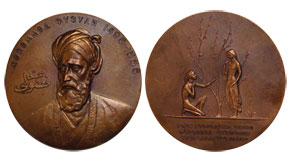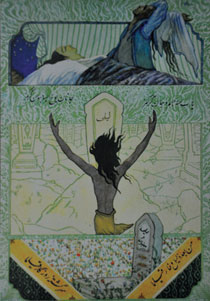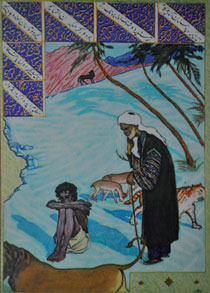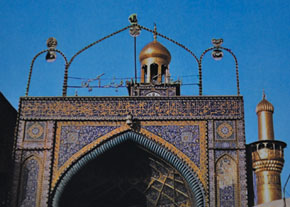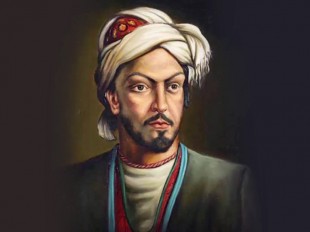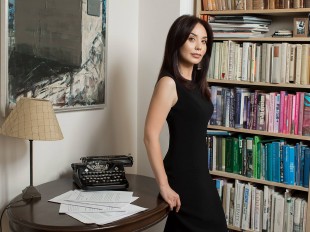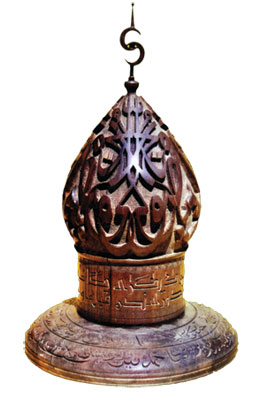 The great Azerbaijani poet Muhammad Fuzuli (c. 1483 – 1556) is one of the nation’s most respected literary personalities. Fuzuli with his Turkic ghazals (a poetic form, usually with love as subject – ed.) and Hafiz in Persian-language ghazals reached such poetic and aesthetic peaks that the poets who came after them were unable to escape their influence and authority. With the rise of Islam, writers who opposed it tried to compete with the Qur’an to neutralize its influence on human psychology, but they failed. In this context, Shahriyar a leading poet of the last century called the Fuzuli’s poetry a door to the Qur’an opening in three languages.
The great Azerbaijani poet Muhammad Fuzuli (c. 1483 – 1556) is one of the nation’s most respected literary personalities. Fuzuli with his Turkic ghazals (a poetic form, usually with love as subject – ed.) and Hafiz in Persian-language ghazals reached such poetic and aesthetic peaks that the poets who came after them were unable to escape their influence and authority. With the rise of Islam, writers who opposed it tried to compete with the Qur’an to neutralize its influence on human psychology, but they failed. In this context, Shahriyar a leading poet of the last century called the Fuzuli’s poetry a door to the Qur’an opening in three languages.To understand and appreciate the legacy left by Fuzuli, several important factors should be considered:
1. The master wrote his sublime works in three languages – Azerbaijani Turkic, Arabic and Persian – which were the main bearers of the scientific, philosophical, artistic and aesthetic values in the Eastern culture; thus he represented the culture of three nations.
2. He tested himself skilfully in both prose and poetry, producing works that set a pattern and model for the literature of the Middle Ages;
3. His literary heritage is substantial, including the wonderful Divan – a collection of poetry in both Turkic and Arabic, a collection of odes in Arabic, the voluminous work Hadigat us-sueda (The Garden of the Joyful) written in rhythmic prose, the poem Leyli and Mejnun in Turkic, a range of allegorical works, and philosophical and didactic treatises;
4. Fuzuli first wanted to be a scientist and his studies gave him an encyclopaedic knowledge. Poetic inspiration eventually overcame science, but the knowledge he gained greatly enriched the expression of his artistic and aesthetic ideals through poetry;
5. He had a thorough understanding of Eastern poetry and made adept use of all its forms, expressions and ploys; he was very precise and accurate in polishing a poem to achieve harmony of sound, form and meaning; perhaps none was as proficient in this.
Because he came to the poetry from science, there is a logic to the flow of his poetic thought. He wrote:
….poetry without science is a wall without foundation.
According to Fuzuli, science is one world, poetry another and it is very difficult to enjoy both. But he managed it; by grafting elements of both and creating a sequence between science and art, logic and poetic imagination, he produced jewels for the literary treasury of the East.
In his poetry, mind and logic, heart and spirit meet, complement and are mutually enriched. The poetry resulting from this encyclopaedic intellect embraces:
1. Religious sciences, the Qur’an and Islamic education;
2. Natural sciences;
3. Astrology and cosmology;
4. Philosophy and wisdom;
5. Imagination;
6. Poetic and philological theory.
Fuzuli employed a vocabulary familiar to most of his contemporaries but his distinction lay in the precise selection, logical flow, aesthetic arrangement and multiplicity of meaning that he achieved. Thus the outstanding features of a Fuzuli poem are:
1. The exceptional arrangement of rhyme, rhythm and internal musical structure;
2. Rich and colourful artistic description and image;
3. Complete poetic images and categories;
4. Profound ideas and content;
5. Beauty of language and style, detailed imagination
To determine his place in Eastern thought on art and aesthetics we should apply to the poet’s own words. Besides his theoretical knowledge he was a man who viewed the world and its reality with both discernment and enjoyment; he was wise man and lover. A word for Fuzuli was an ocean of erudition and poetic treasure arising from the junction of two precious jewels – thought and spirit – i.e. those who cannot swim cannot reach the precious stones in this ocean and are not considered wise:
Olmayan qavvasi-bahri-marifat arif degil, (One without the ability to dive is not a wise man)
Kim, sedef terkibi-tendir loloi-shehvar soz. (Because a word is a pearl in the oyster)
To familiarise ourselves with Fuzuli’s world, we need to look at several important features of the philosophical context. The touchstones of this philosophy are mental maturity and reality.
I. The philosophy of love:
Fuzuli is hailed as both poet of love and poet of sorrow, but few go on to explain this. The main strand of thought catching the eye in his poetry is the philosophy of love:
I’m in love and my words are always passionate.
This love is, first of all, a source of endless delight and the poet, in his Turkic-language Divan, connects it to Justice:
Ey Fuzuli, intehasiz zovg buldun eshgden,
Boyledir her ish ki, Haqq adiyle gildin ibtida
The artistic and aesthetic beauty of the poetry derive from Fuzuli’s use of imagination and fable. Sometimes the fable is interpreted as mysticism and this is wrong. European orientalists regard the fable, which is an important branch of Islamic culture and thought, as a school of rich and varied esoteric learning. Unlike the mystical movements observed in various other cultures, the Islamic imagination is a model of original, dynamic, dialectical thought still alive today.
In this way of thinking, love in its broadest meaning encompasses the whole mental, moral and worldly life of humanity. Without love nothing may exist. Even the maturity of belief and faith is associated with love: it is love for God (Allah) that takes humanity to moral and spiritual maturity. Light, expression, intellect and love, initially given by God, are equal, which is why love is the essence of life and the spirit. God gave humanity intellect and clear thinking to help us to understand, and love is considered a source of higher knowledge – i.e. esoteric understanding. Mature love is the glory of God.
The notion of love in Fuzuli’s poetics has several important features:
1. A person’s moral and conscious contact with his/her God out of pure belief and faith is based on a higher, spiritual love.
2. A person’s secular and moral life, benefiting fully from reality, is expressed in terms of love.
3. Love is a virtue and value peculiar to the human character, in this meaning love is the essence of mankind, its moral and ethical purity, spiritual and mental development; it is the essential regulator of desire and intelligence.
4. Love is light and abundance revealed to the human heart by God, and a person finds spiritual enlightenment through that love. Someone who reaches the point of awareness by purifying his desire begins to understand truth by understanding himself.
This broad and comprehensive notion of love is already present in the works of the earlier Azerbaijani poet Nizami Ganjavi (1141 to 1209). According to Nizami and Fuzuli, the existence of all space, its order and continuity, is based on the fascination of love; there is nothing outside this fascination. Love is a force that connects the person to charm, beauty and the harmony of reality. Worldly love is a bridge to the glory of God and acts as foundation. The poet does not consider worldly life to be false. In his Leyli and Majnun (L-M) he sees it as a test:
Amma demezem yalandir ol hem (I would not say that it is not real)
Sarmanizli-imtahandir ol hem (It is an examination)
But humanity’s worldly life is not eternal, it ends in death. The poet reminds us that besides this world there is another. In this world people attain intelligence, but in the other world they attain the life desired:
Bunda yete rutbeyi-kamala,
Onda yete dovleti-vusale. (L-M. 21)
The beauty that exists in reality is the appearance and sign of the wisdom and maturity of God. If the poet writes often about beauty, there is no doubt that he is describing the beauty of reality, a person’s beauty and magnificence occupy a special place.
Someone’s feeling for beauty derives from their interest in maturity, truth is the source of all beauty and maturity. The beauty existing in reality is inseparable from the sun of truth, the metaphorical world – i.e. the world’s creatures are considered to be manifestations of the unique truth:
Xubsuretlerden ey naseh, meni men’ etme kim,
Pertovi-anvari-khurshidi-hagigatdir mejaz.
In this couplet, the poet replies to a hermit who prohibits him from enjoying a beautiful image that beauty is a brilliance derived from the sun of truth.
Fuzuli the man of wisdom is not different from Fuzuli the lover and the poet and these three aspects complement each other. The notion of love which controls his poetic spirit is held to be humanity’s greatest virtue and value and covers all levels of the world of existence:
1. The world of existence, the wisdom and purpose of creation;
2. The balance, intelligence and beauty found in reality;
3. The human being, his place in the world of existence, his intellectual, moral and spiritual evolution;
4. People’s love of life, joy, sorrow, suffering and excitement;
5. Their search for literature, truth, and justice.
II. The philosophy of sorrow:
While Fuzuli’s love is inexhaustible, his sorrow and suffering do not end. This sorrow is not limited to basic concerns about housing, social and public problems and the other hardships that make human life more difficult. These sorrows and sufferings are connected with moral and psychological factors that keep the human spirit in constant anxiety. The poet provides this example to convey the extent of the problem:
Bu derdler kim, menim vardir, beirin bashina goysan,
Chikhar kafer jehennemden, guler ahli-azab oynar.
If you put my sorrow on the head of a camel, the infidel will rise from Hell. Here the poet points to an example from the Qur’an and the Bible. The 40th ayat of the A’raf sura in the Qur’an states:
Verily, those who belie Our Ayat (proofs, evidence, verses, lessons, signs, revelations, etc.) and treat them with arrogance, for them the gates of heaven will not be opened…
This issue is described as follows in the Bible
They will not enter Paradise even if the camel goes through the eye of the needle
When does this suffering arise? When a person’s environment does not meet his worldly, mental or moral requirements. Sometimes the opposite can happen: when there is a deep abyss between the higher mental and moral values aspired to by people possessing intelligence and soul, and existing bitter reality. On the other side, temptation pursues humanity like a shadow as an obstacle to moral development. There is no escape. In short, there are many worldly desires, few chances in life, death is inevitable, it is a sad predicament:
Ey Fuzuli, galmisham heyretde, bilmen neyleyim:
Dovr – zalim, bekht – naferjam, teleb – chokh, omr – az. (161/7)
Fuzuli is not just a simple lover, he is not someone to fit into a narrow frame of temptation and materialism, neither is he an ascetic. Generally, Islam does not accept ascetism or a monkish life. In the 77th ayat of the Gasa sura in the Qur’an people are advised to accept their share and their fate. There is one great virtue that distinguishes humans from other creatures and makes them God’s designated governors on Earth, and this is the light of intellect and the soul they have been given. People can reach maturity by means of that light and the greatest obstacle on the way is temptation. According to Fuzuli, all suffering derives from temptation. This lover, wise man and poet expresses in his poetry the sorrow, excitement and psychological experiences that give him pause for thought on his life’s journey from imperfection to maturity. In this sense, the contrast and gulf between the poet’s higher desires and reality is very deep. The truth and justice that he wished to understand and attain are distant and inaccessible. And hope for convergence of desire and reality is simply conscious consolation. The poet, who is confounded by the influence of feeling and thought, cannot find consolation for his anxious soul. Is there an end to this sorrow and anxiety? Why cannot Fuzuli find an end to his tears and pain?
The feelings that derive from anxiety and moral suffering are completed with a gentle artistic question:
Shebi-hijran yanar janim, toker gan cheshmi-giryanim,
Oyadar khelgi efganim, gara bekhtim oyanmazmi?
At first sight, the answer is simple and logical: as long as humanity lives, it burns like a candle, its sorrow, tears and suffering will not end:
Bir shem´i-shebistani-belayem ki, degil kem
Ta men diriyem suzi-dilu eshki-revanim.
This means that, as the person lives, his love, sorrow and suffering will not end because life itself is a matter of love, sorrow and struggle.
On the other hand, the hope for covergence is some psychological consolation:
Ey Fuzuli, shami-qem encamina yoxdur umid (Hey Fuzuli, there is no hope for salvation from sorrow)
Bir tesellidir sene ol soz ki, derler var subh. (The only consolation is that morning will come)
This wise man who, with his intellectual and moral stature and spiritual development, does not fit the narrow confines of bitter reality, comes to the following conclusion:
Hasilin evvel gemi-janandir, akhir terki-jan
Bu imish gismet, Fuzuli, khah agla, khah gul.
The twists in a candle are unfurled only when it burns to the end, as the ties linking the person to the world are not revealed until his life finishes. Yes! The spirit of humanity will be freed from anxiety only when its imperfect body combines with the flow of reality to reach the ocean of non-existence and eternity:
Dehr bir seylabdir mulheg edem deryasina,
Biz ki, sergerdaniz, ol seylaba dushmush kharu khes.
Jizginir kharu khes ol seylab oldugca revan,
Yetmeden deryaye, rahet mumkun olmaz bir nefes
Thus, the spiritual anxiety of the wise man examining reality and the difficult, contrasting poles of human existence with its love and joy, spiritual struggle and psychological insights, are expressed in Fuzuli’s poetic artistry. This philosophical sorrow and suffering is connected with the imperfections and contradictions that humanity faces in its earthly life, in reality. Human psychology at all earthly levels – the private, public and social environment, in its ethical, moral, mental and spiritual dimensions - seeks maturity, peace of mind and harmony. When these are disturbed, then anxiety and spiritual concussion take over. At the same time, Earth-bound humanity, where death is unavoidable, searches for an immortal and eternal truth, and this may only be found on a moral and spiritual level. The great artists like Nizami, Rumi, Dante, Yunus Emre and Fuzuli often created an artistic embodiment of such values in their works.
III. The double format:
To understand Fuzuli’s poetic thinking and aesthetic imagination we must touch upon the double format here. Mythological, cosmological and cosmogonic beliefs prevalent in ancient times contrasted phenomena such as hot and cold, satiety and hunger, night and day; birth and death were believed to be displays of good and evil.
The ancient Egyptians imagined the world as opposites facing each other. This simple view is also observed in the mythology of ancient Turks as well as Azerbaijanis: white and black (eg the white ram – black ram imagery in folktales), light and dark world. In ancient Mesopotamia the contrast of day and night were considered symbols of life and death. The Azerbaijani philosopher Shihabaddin Suhraverdi held that unity and plurality are connected in one truth and dualism is conditional because the truth is one. Darkness is recognized because of light; if there is no light, there will be no darkness. The roots of dualist thinking can be seen in the Qur’an and other Islamic sources: the external life revealed by the feelings (the world of property or evidence), the world of angels (spirits) and death which is not revealed by feelings – the two aspects of the dual structure do not deny each other, rather, they condition each other. Humanity itself consists of two poles; it is a unity of nature and intellect. If the external appearance and the body are created from the soil, the spiritual world – i.e. the soul and the mind are expressed in moral values.
Torpag idim, eyledim bir insan, (I was earth and became human)
Mustovjibi-aglu, gabili-jan. (With mind and soul)
Human life is regulated by meetings of the two poles. Desire is based somewhere in the middle, between body and the spirit and links the person to the world. But because the main value is determined by the second pole, the person will nurture and mature his desire, without it he cannot reach the moral objective. In this bipolar system mankind’s goal is to reach mental and moral maturity and the higher truth.
IV. Aesthetic thought:
Eastern aesthetic thought has it that all beauty and proportion existing in nature is an appearance of the world of Angels (spirits). The main source of aesthetic truth is the world of death, which has no room in the imagination; the artist creates a link to reality by means of the imagination. From this point of view, the symbol is a means of contact between the ideal created in human imagination and the truth.
Because nature’s evolution arrived at humanity, the human being is considered the most intelligent, mature and beautiful form of creation. The notion of ahsanut-tagvim (the best format) (Tin: 4) given in the Qur’an confirms this idea. The maturity and importance of a human being is also judged by the two elements it contains – natural and divine. Human beauty is valued not for its external and physical form but for mental and moral virtue. Islamic thought maintains that the maturity of the world of existence and stages of moral development are not realized horizontally, but vertically – i.e. progressing towards the truth.
On the other hand, there is such an unbreakable link between the style of expression in Eastern poetry and its meaning that, according to Gustave Grunebaum, such unity may not be found outside Muslim culture. The poetic word and way of thinking is distinct from simple language and logic. If we employed the words in simple meaning and format, they would not have emotional or aesthetic impact. The theoretician in Eastern poetry Abdulgahir Jurjani (died 1078) highlighted this feature of poetic language, saying:
….the most beautiful speech is the word that impacts upon the soul and the heart before it reaches the ears.
Fuzuli’s poetry especially possesses this feature.
In classical Eastern poetry the sequence between word (image - form) and meaning is expressed as images of the meaning. At the same time, the new artistic context that appears when you pass from one meaning into another is called the meaning of the meaning; Jurjani calls it the spirit of the poetry. Words may pass from literal to metaphorical meanings and onto deeper artistic and symbolic interpretation; now studied as semiotics.
Unfortunately the aesthetic beauty of Fuzuli’s poetry is lost in translation. He polished words to achieve both musical harmony and imagination. In one couplet describing God, he uses the words var and yokh (there is/ is not) three times and creates and image even from this:
Ey vari yokh eyleyen, yokhu var, (Ay, the one who turns everything to nothing and nothing to everything)
Yokh varligunda zannu inkar (There is no doubt about your existence)
In another example, the sound “d” is used seven times in a couplet, twice in three words and provides beautiful musical harmony and a delicate play of meanings:
Dahanin dardima darman dedilar jananin,
Bakhdilar dardima yokhdur dedilar darmanin
The inner musicality is very strong in his poetry. The words used in both lines in the following couplet conform fully with each other in their rhyme, rhythm and syllable division, creating musical harmony:
Hasilim yokh sari-kuyinda baladan geyri,
Garazim yokh rahi-eshginda fenadan geyri
His artistic description has a certain structure, i.e. it is not just about the physical resemblance between two parts. The comparisons, parallels and analogues used in the description awaken the aesthetic tastebuds and give food for intellectual though, leading to understanding.
Garmdir shamu sahar mehrinle charkhi-lajivard,
Gah sirishki-al eder izharu gah rukhsari-zard (F.D.s.111)
The destiny of the blue (the heavenly dome) is to live with the love (mehr) of the Eternal Lover (Azali Mashug), it either sheds red tears or shows its yellow face – i.e. there is aren analogies between red tears (sirishki-al) the sunrise, yellow face (rukhsari-zard) and sunset. Several gentle images and artistic ploys characteristic of Fuzuli are used in this couplet:
1. The contrast of sunrise and sunset, day and night is conveyed in beautiful artistic euphemism.
2. The phrase charkhi-lajivard (blue dome) invokes the sky as a metonym.
3. The word mehr is a pun here invoking both love and the sun:
a) The sky is founded on the warmth of His (the Truth) love;
b) The sky relies on the heat of the sun.
4. The sky will either shed bloody tears, or will show its yellow face. In this phrase, the sky is personified.
5. The bloody tears of destiny are compared with the sunrise and the red horizon and the yellow face is compared with the sunset and becoming pale. An imaginative comparison.
6. The candle and the morning used in the first line appear in the second line in reverse order (red tears and yellow face), there is a play on involution and evolution in the couplet.
Bir musevvirdir ki, zarrin kilk ile her gun chakar,
Safheyi-gerdune negshi-arizi-dildar subh.
The morning and sun rise is portrayed here as the work of an artist: like an artist he painted the face of his beloved in golden hue on a blue panel. There is a secret relation, a parallel, likeness between the face of the beloved and the sun. The light of morning and the sun is compared with lines painted in gold and there is also a secret resemblance. The morning paints the picture of sun on the sky every day. There is a gentle personification. Safheyi-gerdun is an artistic metaphor: the sky is compared with the page. As the artist paints the picture on paper, so the rays of the sun paint the image of the beloved in golden hue. There is logic and balance between all words and phrases. In a wise interpretation God is a painter, the sunrise and morning His embodiment. Fuzuli’s Divan is a unique treasury, stacked with artistic, metaphoric and ironic planes of imagination, open to rich layers of symbolic interpretation.
The poet did not belong to the official religious order and benefited from the data of science and the wisdom of the Middle Ages, the Qur’an and Islamic education, from the teeming spring of fable and all the opportunities and detail of Eastern poetry. He embellished his world of art with the values of knowledge and composed his thought into a musical structure of many roots, polishing the words with gentle imagination into poetic course.
The spiritual emotions of a wise man aware of the truth and the mature evolution of his artistic and aesthetic ideals are key. The darkness of temptation and moral enlightenment, the psychological and spiritual excitement that he felt in the gulf between reality and the world desired, the sounds of suffering and struggle, can all be heard in the rich artistic and symbolic imagery found in the literary heritage of Muhammad bin Suleyman - Fuzuli.
